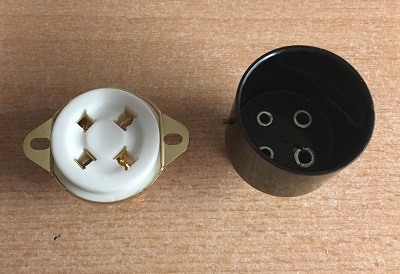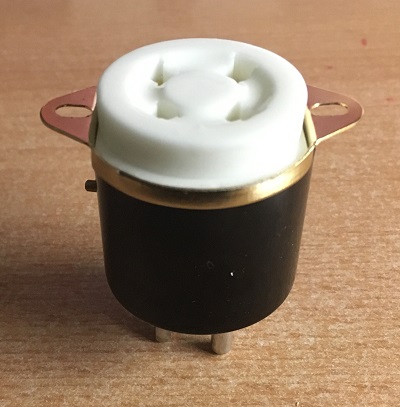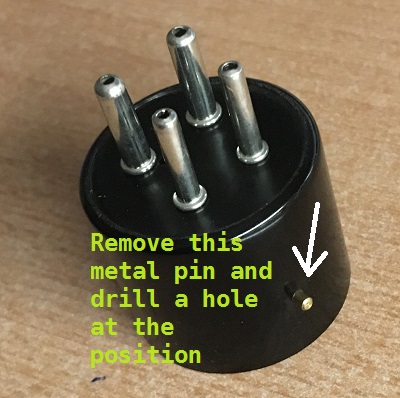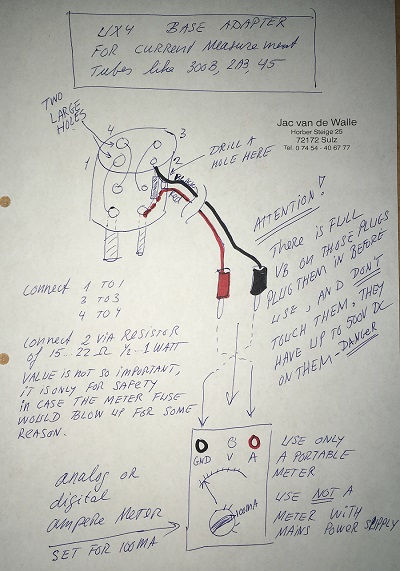Construction of tool to measure plate current
Description
There are many ways to avoid plate current measurements, but it is actually the most important measurement, and with this handy tool, it can be done nicely, and direct. We sell the ceramic socket, and the plastic UX4 tube base for it.
You could leave the metal flange ring on the UX4 socket, it is more handy to pull out the adapter. Or remove the flange, it looks nice that way.
FOR LEGAL REASONS WE HAVE TO SAY IT. This is dangerous, because of high voltage. For this reason, this is not a building instruction or a working instruction. It is only like how I build or use such a tool myself.
The idea is, to cut open the anode connection, and put an ampere meter in the loop. However this could damage the amplifier, if the ampere meter fuse would blow by mistake. For instance, it would blow the fuse when you set the meter for 100uA by mistake, and the tube will pull 100mA. In such a case, the fuse will blow, and the circuit is open. The output transformer (which has large inductance) will try to keep the current flowing, though this is impossible of course. I mean that's what the fuse is for. Just, if that happens, the voltage across the SE transformer will ramp up to several 1000 Volts, and may cause some partial shorts in the primary winding, or damage the isolation from primary to secondary. For this reason, inside the socket, a resistor is mounted across the ampere meter. This resistor is high enough, not to impair the current measurement, but it is low enough to prevent the transformer voltage from ramping up in case of a blown fuse. So when you do make a mistake, or when the amplifier does produce crazy surge current, it will only blow the internal fuse of the ampere meter, but the amplifier itself keeps playing normally, and there is no damage.
So don't be surprized to find such things as crazy surge current. This is by definition a tube killer. There is no such tube which doesn't suffer from this. A surge current through a barely warmed up tube equals a use of 5...25 hours, or even more. Which in most cases is more than the life time use of the listening session itself.
So when the tool is ready, begin with the ampere meter at 500mA, and then go to a more sensitive range, when it works well.
Things to be VERY careful with:
- The banana plugs both have the full anode voltage on them, which can be 550 Volts or more. For this reason the banana plugs must be inserted in the ampere meter before the amplifier is turned on.
- When the amplifier is turned off, THEORETICALLY and by law, all voltages at the INSIDE should drop below "touchable" levels within 20 seconds. This is definitely disrespected by many amplifier builders. So even when switched off, and even when the tubes are cold, etc, there may be high voltage on those plugs for an hour or half a day. The removal procedure is: Switch off the amplifier, take out the tube when cold, then remove the adapter from the amplifier, and only after that you can handle the banana plugs. So again, as long as the adapter is inserted, the banana plugs may unexpectedly still have high voltage on it.
- The insertion procedure is equally important. So when the amplifier is off, and the tubes are cold, first connect the banana plugs into the ampere meter, and only after that insert the adapter in the amplifier. If you do it nicely like that, things won't go wrong.
- The ampere meter should only be of portable type, with a plastic case. Any kind with a mains cable on it, may not be able to handle 500 Volts to ground, for both terminals.
- Do not connect it to an oscilloscope, to see AC signal, because these have always one end grounded, and the other end may not handle 500V well. This would require two 1:10 probes, a safe way to connect the probes to the banana plugs, and the ability for the scope (and the user) to do a differential measurement, and then this will even work very nice. That will be the case, when you can invert one channel, and then add both channels. Take into acount, you measure across the internal resistor in that case, and you need to calculate the voltage to current conversion rate.
- Never pull out a tube from a working amplifier. This can be the death of the SE transformer, the power supply capacitors, or the tweeters of the speaker cabinets.



